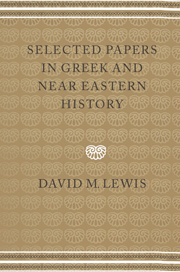Book contents
- Frontmatter
- Contents
- List of plates
- Preface
- Systems of reference
- GENERAL
- ATHENIAN
- NEAR EASTERN
- 31 The Persepolis Fortification Texts
- 32 The King's dinner
- 33 Datis the Mede
- 34 Persians in Herodotus
- 35 The Phoenician fleet in 411
- 36 Persian gold in Greek international relations
- 37 The first Greek Jew
- 38 Review of J. N. Sevenster, Do You Know Greek?
- Bibliography
- Publications of David M. Lewis
- Indexes
31 - The Persepolis Fortification Texts
Published online by Cambridge University Press: 15 January 2010
- Frontmatter
- Contents
- List of plates
- Preface
- Systems of reference
- GENERAL
- ATHENIAN
- NEAR EASTERN
- 31 The Persepolis Fortification Texts
- 32 The King's dinner
- 33 Datis the Mede
- 34 Persians in Herodotus
- 35 The Phoenician fleet in 411
- 36 Persian gold in Greek international relations
- 37 The first Greek Jew
- 38 Review of J. N. Sevenster, Do You Know Greek?
- Bibliography
- Publications of David M. Lewis
- Indexes
Summary
With over 2,100 texts published, the Persepolis Fortification Texts in Elamite, transcribed, interpreted and edited by the late Richard Hallock, already form the largest coherent body of material on Persian administration available to us; a comparable, but less legible, body of material remains unpublished, as does the smaller group of Aramaic texts from the same archive. Essentially, they deal with the movement and expenditure of food commodities in the region of Persepolis in the fifteen years down to 493.
There is no up–to–date general account of these texts. Hallock's own contribution to Cambridge History of Iran ii (1985) is unchanged from a preprinted version circulated in 1971, and a good deal has happened since then. Besides substantial linguistic contributions by Gershevitch and Hinz, I single out one article by Hinz on the details of the administration, one by Dandamaev on dependent populations, one by Sumner on the settlement patterns of the Persepolis plain. There is a book–length treatment of the evidence of the tablets for religion by Koch. The names in the tablets have been fully discussed by Mayrhofer, but we badly need a prosopography; most of my own published work on the tablets concerns prosopographical matters. Some of the material has begun (very slowly) to enter the more general literature. It is not only the text of the tablets which is important. The sealings which they bear provide one of our largest coherent bodies of seal material, capable of throwing a flood of light on seal–usage and arthistory. Hallock devoted a preliminary article to this; a full publication is in the hands of Margaret Cool Root.
- Type
- Chapter
- Information
- Selected Papers in Greek and Near Eastern History , pp. 325 - 331Publisher: Cambridge University PressPrint publication year: 1997



